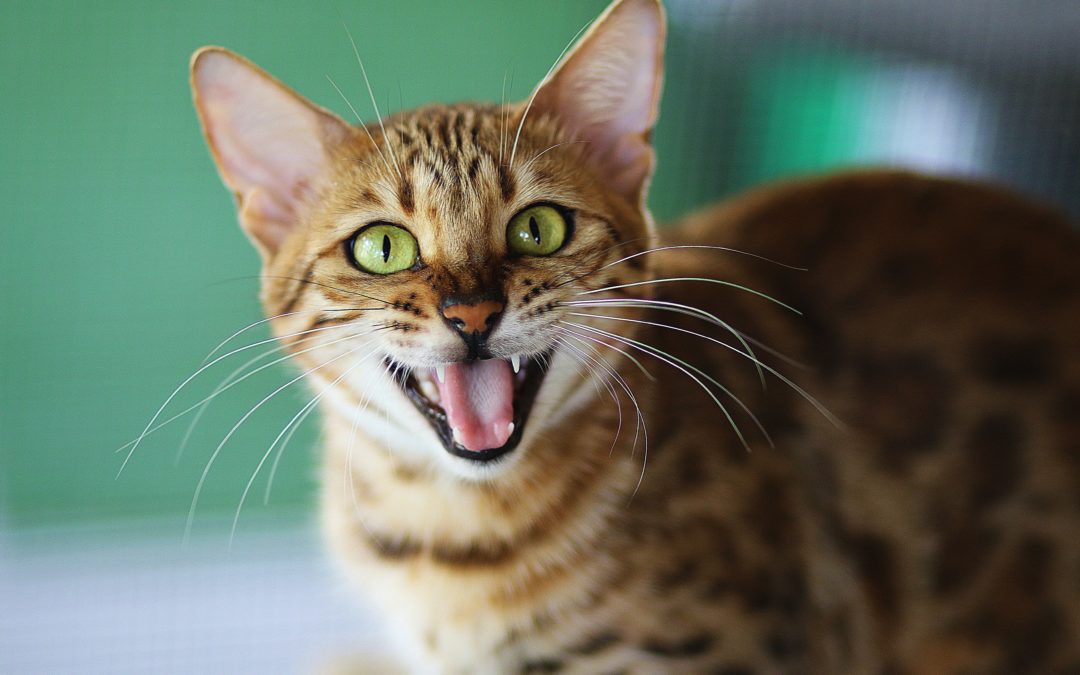Tooth resorption is incredibly common in cats who don’t have routine dental care. In fact, 20% to 60% of cats experience this issue at some point in their lives. Even cats without plaque and tartar buildup can still suffer from tooth resorption (and it can be very painful!). This is why it’s important to keep an eye on what’s happening in your cat’s mouth and catch signs before they start experiencing pain and treatment becomes more difficult.
What is Tooth Resorption in Cats?
First, it’s helpful to understand the anatomy of the tooth. Your cat’s teeth consist of two portions. The top portion, called the crown, is above the gumline and is covered in a protective outer layer of enamel. The bottom portion of the tooth, below the gumline, is the root. The root, which is covered in cementum, extends into the bone of the jaw and holds the tooth in place. Running throughout both portions of the tooth is a hard, bony middle layer called dentin. The tooth also contains a central chamber, the pulp, which consists of connective tissue, blood vessels, nerves, immune cells, and dentin-producing odontoblast cells.
The process of tooth resorption is caused by odontoclasts. These are cells are responsible for normal resorption of the roots of deciduous or baby teeth during kittenhood and for maintaining the adult tooth structure. When these odontoclast cells are unable to shut off, the tooth begins to erode and is absorbed by the body. Resorption begins at the base or neck of the tooth, where it can’t be seen without x-rays, damaging the cementum and progressing into the dentin. It then spreads to the crown above the gum line. At this point, it’s more easily visible and will also be painful for your cat because nerves are exposed and the gum becomes inflamed. The surrounding gum tissue may grow over the lesion to try to protect the area, and the enamel may be resorbed or may fracture due to loss of the underlying dentin. Unfortunately, this damage cannot be reversed.
What are the Causes of Tooth Resorption?
The cause of tooth resorption is unknown, but risk factors such as age and concurrent dental disease increase its likelihood. Nearly 75% of cats with this issue are five years or older.
Signs of Tooth Resorption in Cats
If your veterinarian is conducting regular dental exams, the likelihood of catching tooth resorption early greatly increases. They’ll be looking for visible signs by examining the mouth and teeth, getting x-rays to see below the gumline, as well as looking for indications of pain or discomfort. But you can (and should) also play an important role.
If you notice any behavior changes in your cat, see your veterinarian. Cats are great at hiding pain. We tend to notice something is “off” when they suddenly change their normal behavior or routine. Look for things like:
- Eating more slowly than normal
- Eating less than normal
- Refusing to eat
- Sensitivity to being touched on the face or cheeks
- Aggressive hissing, nipping, or swatting that’s out of character (particularly when being petted or given treats)
- Pawing at the mouth
- Drooling
- Bleeding from the mouth
- Vocalizing
- Weight loss due to eating less
- Bad breath
- Sudden change in activity level
- Red gums
- Messy eating with food falling out of the mouth
- Noticeably eating only on one side of the mouth
Cat Tooth Resorption Treatment
If your cat is diagnosed with tooth resorption, the most common treatment is the removal of the affected tooth. There is no way to repair the damage or stop further erosion and pain without removing the tooth entirely.
Due to the weakened state of the tooth, extraction can be difficult. To remove the tooth, a surgical approach is often necessary. This requires separating the gum tissue from the bone and then removing the damaged root and bone. The flap of gum tissue that was separated is then used to cover the holes left by the extraction.
In cases where dental x-rays show that the entire root structure system has been resorbed, and only the crown remains, your veterinarian will perform a crown amputation. This procedure is faster and less involved. There is less trauma to the gums and bone, and the healing process is quicker.
It is critical to follow your veterinarian’s discharge instructions closely after the procedure to avoid complications. Be sure to give all medications, especially those for pain, even if your cat appears fine.
Can You Prevent Tooth Resorption in Your Cat?
Yes and no. Since there isn’t a clear cause for tooth resorption, it’s impossible to say we can definitively prevent it. But great oral care and regular oral exams by your veterinarian are your best weapons.
Make dental care part of your daily routine with your cat.
Brush Your Cat’s Teeth Daily
Get them comfortable having their teeth brushed with a small cat/dog toothbrush or your finger and pet-specific toothpaste.
Use Dental Care Additives
You can get water and food additives designed to improve dental health.
Try Dental Care Treats
There are lots of treats on the market that help maintain your cat’s dental health.
Trust the Experts
Look for the Veterinary Oral Health Council (VOHC) seal of approval on dental health products to ensure your cat is getting effective dental support.
Probiotics
By keeping your cat’s gut microbiome in balance, you are boosting their immune system and helping it function better. Additionally, they can help keep the oral microbiome in balance.
See Your Veterinarian Regularly
Have your cat’s teeth checked at least once a year. Your veterinarian may recommend more frequent check-ups based on your cat’s current dental condition and history. They’ll also let you know when dental cleanings are recommended.

